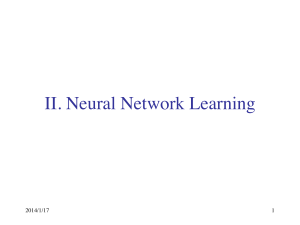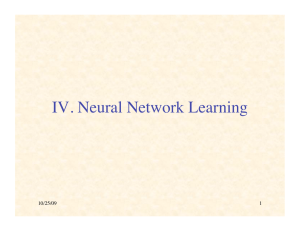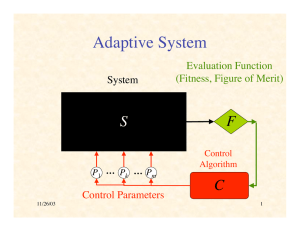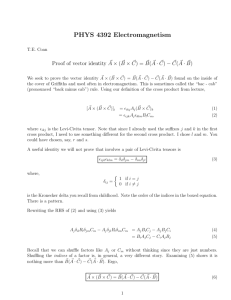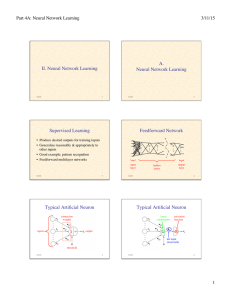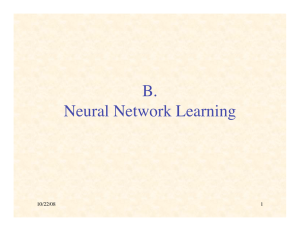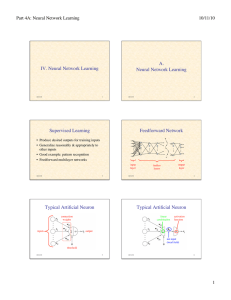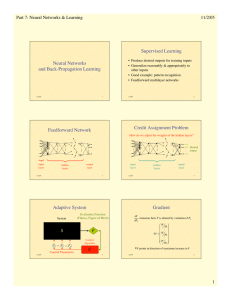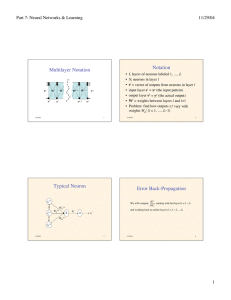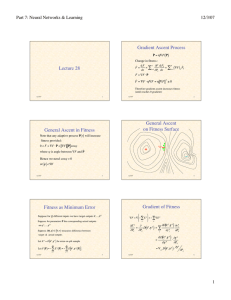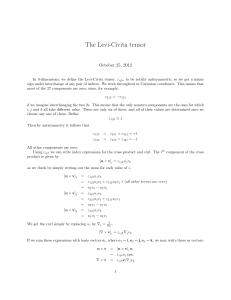Output-Layer Computation ( ) δ
advertisement
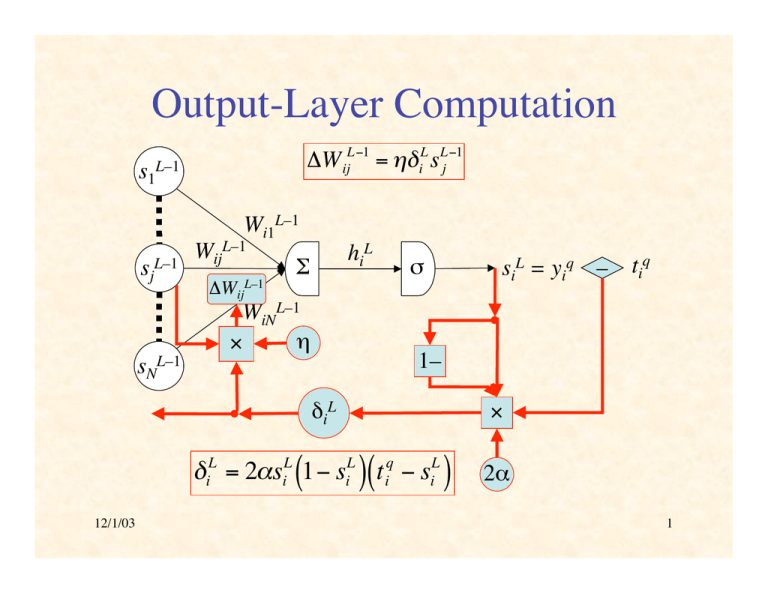
Output-Layer Computation ΔW ijL−1 = ηδiL sL−1 j s1L–1 Wi1L–1 sjL–1 sNL–1 12/1/03 WijL–1 € ΔWijL–1 hiL Σ WiNL–1 η × σ siL = yiq – tiq 1– δiL × δiL = 2αsiL (1− siL )(t iq − siL ) 2α 1 Hidden-Layer Computation ΔW ijl−1 = ηδil sl−1 j s1l–1 W1il Wi1l–1 Wijl–1 sjl–1 € sNl–1 ΔWijl–1 WiN × hil Σ σ Wkil × l–1 η WNil 1– δil × δil = αsil (1− sil )∑δkl +1W kil 12/1/03 si l k s1l+1 δ1l+1 skl+1 Eq δkl+1 sNl+1 Σ δNl+1 α 2 Training Procedures • Batch Learning – – – – on each epoch (pass through all the training pairs), weight changes for all patterns accumulated weight matrices updated at end of epoch accurate computation of gradient • Online Learning – weight are updated after back-prop of each training pair – usually randomize order for each epoch – approximation of gradient • Doesn’t make much difference 12/1/03 3 Summation of Error Surfaces E E1 E2 12/1/03 4 Gradient Computation in Batch Learning E E1 E2 12/1/03 5 Gradient Computation in Online Learning E E1 E2 12/1/03 6 VIII. Review of Key Concepts 12/1/03 7 Complex Systems • • • • • • Many interacting elements Local vs. global order: entropy Scale (space, time) Phase space Difficult to understand Open systems 12/1/03 8 Many Interacting Elements • Massively parallel • Distributed information storage & processing • Diversity – avoids premature convergence – avoids inflexibility 12/1/03 9 Complementary Interactions • • • • • Positive feedback / negative feedback Amplification / stabilization Activation / inhibition Cooperation / competition Positive / negative correlation 12/1/03 10 Emergence & Self-Organization • Microdecisions lead to macrobehavior • Circular causality (macro / micro feedback) • Coevolution – predator/prey, Red Queen effect – gene/culture, niche construction, Baldwin effect 12/1/03 11 Pattern Formation • • • • • Excitable media Amplification of random fluctuations Symmetry breaking Specific difference vs. generic identity Automatically adaptive 12/1/03 12 Stigmergy • Continuous (quantitative) • Discrete (qualitative) • Coordinated algorithm – non-conflicting – sequentially linked 12/1/03 13 Emergent Control • Stigmergy • Entrainment (distributed synchronization) • Coordinated movement – through attraction, repulsion, local alignment – in concrete or abstract space • Cooperative strategies – nice & forgiving, but reciprocal – evolutionarily stable strategy 12/1/03 14 Attractors • Classes – point attractor – cyclic attractor – chaotic attractor • Basin of attraction • Imprinted patterns as attractors – pattern restoration, completion, generalization, association 12/1/03 15 Wolfram’s Classes • • • • Class I: point Class II: cyclic Class III: chaotic Class IV: complex (edge of chaos) – – – – 12/1/03 persistent state maintenance bounded cyclic activity global coordination of control & information order for free 16 Energy / Fitness Surface • Descent on energy surface / ascent on fitness surface • Lyapunov theorem to prove asymptotic stability / convergence • Soft constraint satisfaction / relaxation • Gradient (steepest) ascent / descent • Adaptation & credit assignment 12/1/03 17 Biased Randomness • • • • • • Exploration vs. exploitation Blind variation & selective retention Innovation vs. incremental improvement Pseudo-temperature Diffusion Mixed strategies 12/1/03 18 Natural Computation • • • • • • Tolerance to noise, error, faults, damage Generality of response Flexible response to novelty Adaptability Real-time response Optimality is secondary 12/1/03 19 Student Course Evaluation 12/1/03 20
